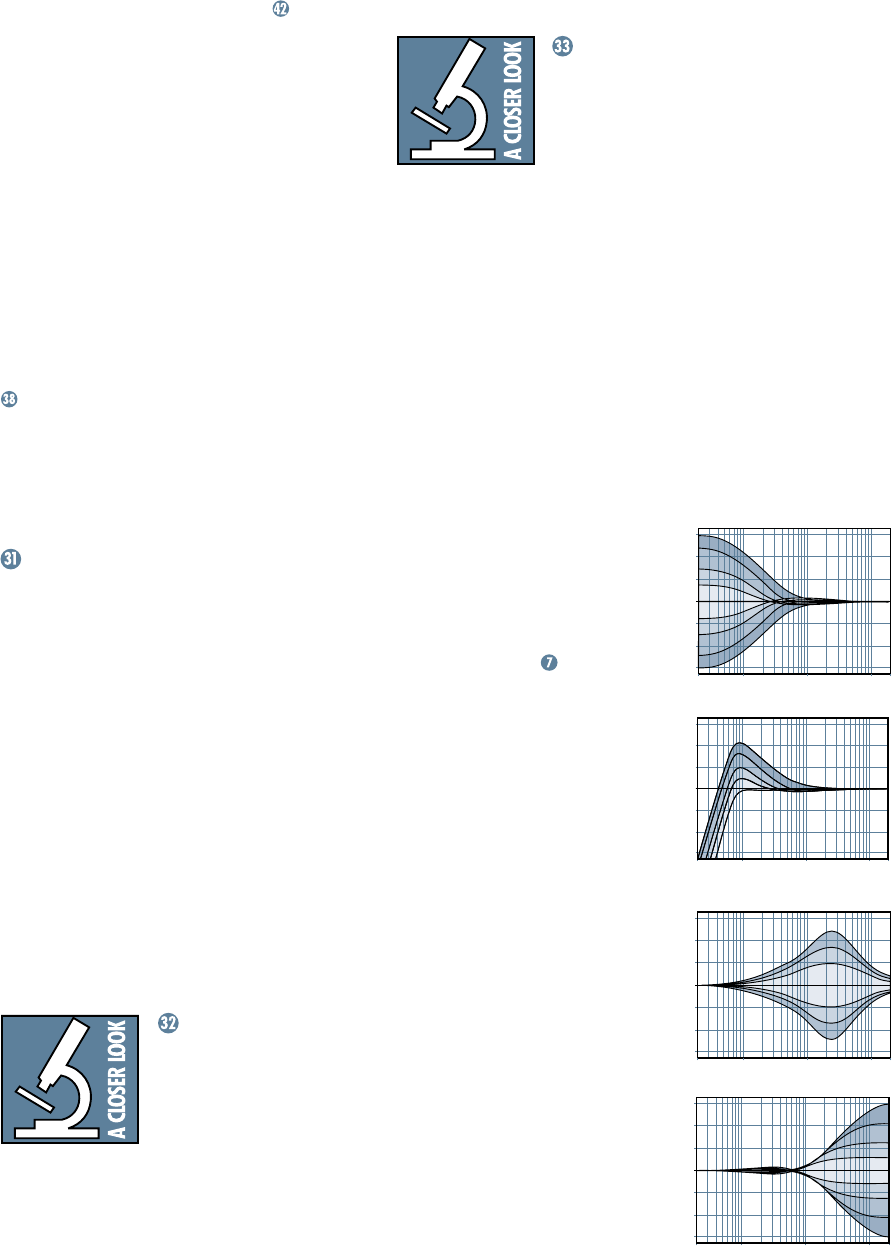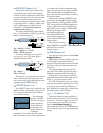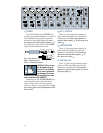
19
and
PHONES
outputs. If you want the
ALT 3–4
signals to go back into the
MAIN MIX
, engage
the
ASSIGN TO MAIN MIX
switch , and the
CTL ROOM/SUBMIX
fader becomes the one
fader to control the levels of all channels as-
signed to
ALT 3–4
.
Another way to do the same thing is to as-
sign the channels to the
ALT 3–4
mix, then
patch out of the
ALT OUT LEFT
and
RIGHT
back into an unused stereo channel (7–8, 9–10
or 11–12 or 13–14). If that’s your choice, don’t
ever engage the
MUTE/ALT 3–4
switch on that
stereo channel, or you’ll have every dog in the
neighborhood howling at your feedback loop.
Another benefit of the
ALT 3–4
feature is
that it can act as a “AFL” (After Fader Listen):
just engage a channel's
MUTE/ALT 3–4
switch
and the
ALT 3–4
switch in the
SOURCE
matrix
and you’ll get that channel, all by itself, in
the
CONTROL ROOM
and
PHONES
.
MUTE/ALT 3–4
is one of those controls that
can bewilder newcomers, so take your time and
play around with it. Once you’ve got it down,
you’ll probably think of a hundred uses for it!
PAN
PAN
adjusts the amount of channel signal
sent to the left versus the right outputs. On
mono channels (ch. 1–6 or 7–14 with connec-
tions to the
LEFT
input only) these controls act
as pan pots. On stereo channels (7–14) with
stereo connections to
LEFT
and
RIGHT
inputs,
the pan knob works like the balance control on
your home stereo.
PAN
determines the fate of the
MAIN MIX
(1–2) and
ALT 3–4
mix. With the
PAN
knob
hard left, the signal will feed either
MAIN
LEFT
(bus 1) or
ALT LEFT
(bus 3), depending
on the position of the
ALT 3–4
switch. With the
knob hard right, the signal feeds
MAIN RIGHT
(bus 2) or
ALT RIGHT
(bus 4). You’ll soon dis-
cover that maybe we should’ve called this an
1404-VLZ
2
, since it really is a 4-bus mixer.
CONSTANT
LOUDNESS ! ! !
The 1402-VLZ
PRO’s
PAN
controls employ a design
called “Constant Loudness.”
It has nothing to do with living next to a freeway.
As you turn the
PAN
knob from left to right
(thereby causing the sound to move from the left
to the center to the right), the sound will appear
to remain at the same volume (or loudness).
If you have a channel panned hard left (or
right) and reading 0dB, it must dip down
about 4dB on the left (or right) when panned
center. To do otherwise (the way Brand X com-
pact mixers do) would make the sound appear
much louder when panned center.
3-BAND EQ
The 1402-VLZ
PRO has
3-band equalization at
carefully selected points
—
LOW
shelving at 80Hz,
MID
peaking at 2.5kHz, and
HI
shelving at
12kHz. “Shelving” means that the circuitry
boosts or cuts all frequencies past the
specified frequency. For example, rotating the
1402-VLZ PRO’s
LOW EQ
knob 15dB to the
right boosts bass starting at 80Hz and continu-
ing down to the lowest note you never heard.
“Peaking” means that certain frequencies form
a “hill” around the center frequency — 2.5kHz
in the case of the
MID EQ
.
LOW EQ
This control gives you up to 15dB boost or
cut at 80Hz. The circuit is flat (no boost or
cut) at the center detent position.
This frequency represents the
punch in bass drums, bass guitar,
fat synth patches, and some really
serious male singers.
Used in conjunction with the
LOW CUT
switch , you can
boost the
LOW EQ
without inject-
ing a ton of subsonic debris into
the mix.
MID EQ
Short for “midrange,” this knob
provides 12dB of boost or cut, cen-
tered at 2.5kHz, also flat at the
center detent. Midrange
EQ
is
often thought of as the most dy-
namic, because the frequencies
that define any particular sound
are almost always found in this
range. You can create many inter-
esting and useful
EQ
changes by
turning this knob down as well as
up.
HI EQ
This control gives you up to
15dB boost or cut at 12kHz, and it
is also flat at the detent. Use it to
add sizzle to cymbals, and an over-
all sense of transparency or edge
to keyboards, vocals, guitar and
bacon frying. Turn it down a little
to reduce sibilance, or to hide tape hiss.
20
Hz
100
Hz
1k
Hz
10k
Hz
20k
Hz
–15
–10
–5
0
+5
+10
+15
Low EQ
20Hz 100Hz 1kHz 10kHz 20kHz
–15
–10
–5
0
+5
+10
+15
Low EQ with Low Cut
20
Hz
100
Hz
1k
Hz
10k
Hz
20k
Hz
–15
–10
–5
0
+5
+10
+15
20Hz 100Hz 1kHz 10kHz 20kHz
–15
–10
–5
0
+5
+10
+15
Hi EQ
Mid EQ


















